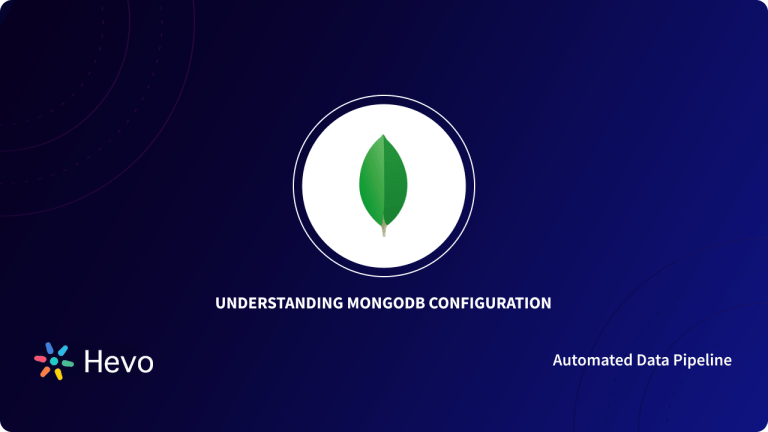Developers have a huge impact on their business’s growth. But to outpace their competition, they need every advantage they can get. That means working with the most agile and automated database so they can accelerate the development of their applications and stay flexible in the long run. For some, this database is MongoDB.
In this article, you will gain information about MongoDB Configuration Files. You will also gain a holistic understanding of MongoDB, its key features, creating MongoDB Configuration files, using MongoDB Configuration files and customizing MongoDB Configuration files. Read along to find out in-depth information about MongoDB Configuration Files.
Table of Contents
What is MongoDB?
MongoDB is a NoSQL database that was developed by MongoDB Inc. and is schema-free. It was designed and created using C++ and JavaScript, allowing for higher connectivity. It uses a collection of documents and has an option for creating schemas. It doesn’t follow the same structure as a traditional database wherein the data is stored in the form of rows. Dive into the use cases of MongoDB and why MongoDB is primarily used.
Key Features of MongoDB
Main features of MongoDB which make it unique are:
1) High Performance
Data operations on MongoDB are fast and easy because of their NoSQL nature. Data can be quickly stored, manipulated, and retrieved without any compromise on data integrity. MongoDB’s Replication enables you to backup & recover data from different servers.
2) Scalability
In the Big Data era, MongoDB data can be distributed across a cluster of machines quickly and equally, free of bulkiness. The scalability of MongoDB handles a growing amount of data capably. Sharding is a process in MongoDB used to horizontally scale the data across multiple servers when the size of data increases.
3) Availability
Data is highly available with MongoDB as it makes multiple copies of the same data and sends copies of data across different servers. In case any server fails, data can be retrieved from another server without delay.
4) Flexibility
MongoDB can easily be combined with different database management systems, including both SQL and NoSQL types. The document-oriented structure makes MongoDB schema dynamically flexible, and different types of data can be easily stored and manipulated.
Hevo is the ideal data pipeline solution for integrating MongoDB as a source, enabling seamless data extraction, transformation, and loading. This ensures smooth data flow and real-time updates, optimizing your analytics and data management processes.
Let’s see some unbeatable features of Hevo Data:
- Fully Managed: Hevo Data is a fully managed service and is straightforward to set up.
- Schema Management: Hevo Data automatically maps the source schema to perform analysis without worrying about the changing schema.
- Real-Time: Hevo Data works on the batch as well as real-time data transfer so that your data is analysis-ready always.
- Live Support: With 24/5 support, Hevo provides customer-centric solutions to the business use case.
ere for a 14-Day Free Trial!” link=”https://hevodata.com/signup?step=email”][/hevoButton]
What is the MongoDB Configuration File?
The MongoDB configuration file provides MongoDB database admins with numerous options and settings for controlling the operation of the database system.
A MongoDB configuration file can be used to configure Mongod and Mongos instances at startup. The MongoDB configuration file contains settings that are equivalent to the command-line options Mongod and Mongos.
Using a MongoDB config file simplifies the management of Mongod and Mongos options, especially in large-scale deployments.
How to Create the MongoDB Configuration File?
This section assumes that you have already installed MongoDB on your system. If you have installed MongoDB with the Brew package manager on macOS, MSI installer on Windows, or yum or apt on Linux, you will find that a default MongoDB configuration file has already been created.
- On Linux, the path to the MongoDB configuration file is located at:
/etc/mongod.conf- On macOS, the path to the MongoDB configuration file is located at:
/usr/local/etc/mongod.conf (on Intel processors)OR
/opt/homebrew/etc/mongod.conf (on Apple M1 processors)- On Windows, the MongoDB configuration file is located at:
<install directory>binmongod.cfgOn Linux and macOS, you have to initialize the mongod daemon process for the MongoDB system as follows:
- On macOS, you can use the following command:
brew services start mongodb-community@5.0- On Linux, you can use either of the following commands:
sudo systemctl start mongodOR
sudo service mongod startIf you used a ZIP or TGZ file to install MongoDB, you will have to create your own MongoDB configuration file. A simple MongoDB configuration file can be found in the next section. After creating the file, you need to initialize your MongoDB instance using the –config or -f alias to mongod. For example,
- On Linux, the command for initializing the MongoDB instance is:
mongod --config /etc/mongod.confOR
mongod -f /etc/mongod.confHow to Use the MongoDB Configuration File?
The following is an example of the default MongoDB configuration file that you will find on the paths listed above:
processManagement:
fork: true
net:
bindIp: localhost
port: 27017
storage:
dbPath: /var/lib/mongodb
systemLog:
destination: file
path: "/var/log/mongodb/mongod.log"
logAppend: true
storage:
journal:
enabled: trueAs you can see, the MongoDB Configuration file adheres to the YAML format (a superset of JSON). The following is a brief explanation of the variables:
- fork is true; this setting enables the daemon mode for mongod allowing you to run the database as a conventional server.
- bindIp is localhost; using this setting forces the MongoDB server to only listen for requests coming from the localhost IP. You can use it to listen to other secure IPs.
- port is 27017; this is the default port used by MongoDB database instances. You can change the port to a custom one if you wish.
- quiet is true; this disables all but the most critical entries in the output/log file. For production deployments, you should set it to false.
- dbPath is /var/lib/mongodb; this setting specifies where MongoDB should store its files.
- systemLog.path is /var/log/mongodb/mongod.log; this is the path where mongod will write its output.
- logAppend is true; this ensures that mongod appends new log entries rather than overwriting existing ones during the server start operation.
- storage.journal.enabled is true; this enables journaling.
How to Customize the MongoDB Configuration Files?
To customize the MongoDB configuration file, use SPACE characters instead of TAB characters for indentation because YAML doesn’t support TAB characters.
1) Security Options
To limit access to your MongoDB instance, you can set the following options:
net:
bindIp: localhost,10.8.0.10,192.168.4.24,/tmp/mongod.sock
security:
authorization: enabledIn the example above, you can see that there are four values to the bindIp variable, that are as follows:
- localhost: This is the localhost access interface.
- 10.8.0.10: This is a private IP address usually used for VPN and local network interfaces.
- 192.168.4.24: This is a private network interface normally used on local networks.
- /tmp/mongod.sock: This is a Unix domain socket path.
2) Replication
A replica set in MongoDB is a group of mongod processes that maintain the same data set. Replica sets provide redundancy and high data availability and are the basis for all production deployments.
The replication option is quite easy and only requires that the replSetName have a value that is consistent among all members of the set. You can consider the following:
replication:
replSetName: set13) Sharding
MongoDB uses sharding to split data across multiple server instances to support high throughput operations on large data sets.
To configure sharding on your MongoDB cluster, you need to configure config servers for storing metadata for the shared cluster and shards that store the data. To configure the config server instances, you can create a new MongoDB configuration file that specifies configsvr for the sharding.clusterRole setting as follows:
storage:
dbPath: /var/lib/mongo/db/configdb
journal:
enabled: true
systemLog:
destination: file
logAppend: true
path: /var/lib/mongo/db/logs/configsvr.log
net:
port: 27002
bindIp: 10.8.0.12
sharding:
clusterRole: configsvr
replication:
replSetName: ConfigReplSetAs you can see, the config servers must be deployed as a replicaset.
You also need to configure a query router as follows:
systemLog:
destination: file
logAppend: true
path: /var/lib/mongo/db/logs/queryrouter.log
net:
port: 27011
bindIp: 10.8.0.17
sharding:
configDB: ConfigReplSet/10.8.0.16:27015To configure the shard servers, you can specify shardsvr for the sharding.clusterRole setting, and if you are running the shards as a replica set, then you should set the replica set name as well:
storage:
dbPath: /var/lib/mongo/db/sharddb
journal:
enabled: true
systemLog:
destination: file
logAppend: true
path: /var/lib/mongo/db/logs/shard.log
net:
port: 27014
bindIp: 10.0.8.18
sharding:
clusterRole: shardsvr
replication:
replSetName: ShardReplSet4) Run Multiple MongoDB Instances on One System
During testing, you might need to run multiple MongoDB instances on your VM or local machine. This can be achieved by using a base configuration for each instance, but you can consider the following configuration values:
storage:
dbPath: /var/lib/mongo/db1/
processManagement:
pidFilePath: /var/lib/mongo/db1.pid- The dbPath value specifies the location of the MongoDB instance’s data directory. Each database should have a distinct and well-labeled data directory.
- The pidFilePath on the other hand specifies where the mongod process stores it’s process id (PID) file.
Conclusion
In this article, you have learned about MongoDB Configuration Files. This article also provided information on MongoDB, its key features, creating MongoDB Configuration file examples, using MongoDB Configuration files, and customizing MongoDB Configuration files in detail. Read further on MongoDB Replica Set Configuration, MongoDB Compass Windows Installation, and MongoDB Count Method.
Hevo Data, a No-code Data Pipeline, provides you with a consistent and reliable solution to manage data transfer between a variety of sources and a wide variety of Desired Destinations with a few clicks.
Want to give Hevo a try? Sign Up for a 14-day free trial and experience the feature-rich Hevo suite firsthand. You may also have a look at the amazing price, which will assist you in selecting the best plan for your requirements.
Share your experience of understanding MongoDB Configuration Files in the comment section below! We would love to hear your thoughts.
Frequently Asked Questions
1. Where is the MongoDB config file?
Default locations include /etc/mongod.conf (Linux/macOS) and C:\Program Files\MongoDB\Server\\bin\mongod.cfg (Windows).
2. How to configure MongoDB database?
Edit the configuration file for network, storage, security, replication, sharding, and logging settings. Restart MongoDB to apply changes.
3. What is the configuration server in MongoDB?
The configuration server in MongoDB is a critical component of a sharded cluster. It stores metadata and configuration settings for the sharded cluster, including shard, chunk, and cluster metadata.










